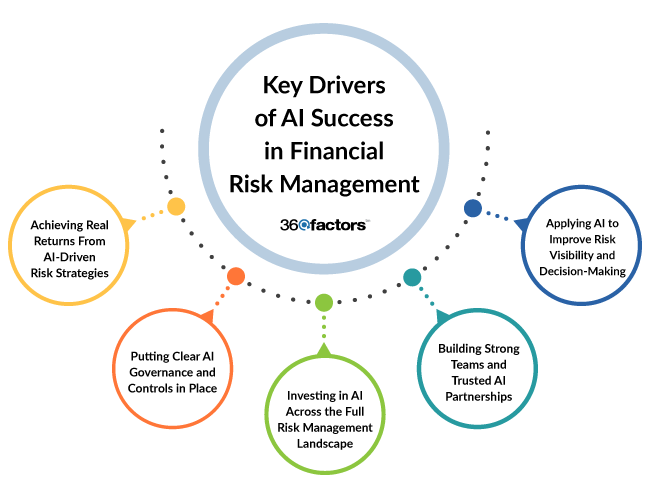Home/ Blog / Key Success Drivers of AI in the Financial Sector for Smarter Risk Management
What distinguishes financial institutions that react to risk from those that stay ahead of it? Increasingly, the answer lies in how they approach artificial intelligence. AI in finance is not just a back-office efficiency tool; it’s becoming a primary capability that shapes how risks are identified, analyzed, and addressed. While many organizations are still experimenting with automation, leading businesses are integrating AI into their risk strategies. The result is faster insights, sharper decision-making, and greater resilience in the face of emerging risks.
Financial institutions are using AI in financial services to transform the entire risk management lifecycle. From predictive risk modeling and fraud detection to automated reporting and real-time monitoring, AI delivers both speed and depth of analysis. More importantly, it enables organizations to move beyond static frameworks and toward dynamic risk oversight that adapts to changes as they occur.
Regulatory requirements, growing digital complexity, and market volatility mean integrating AI into financial risk management is essential. This blog focuses on what drives enterprise‑wide AI adoption from surface‑level pilots in risk management. Organizations that fully embed AI in finance operations achieve higher data accuracy, sharper predictive insights, and improved operational efficiency. These benefits extend across all finance functions, with risk management emerging as a leading area of AI‑driven innovation.

Proven Drivers for Risk Management Success with AI in the Financial Sector
1. Adopting AI for Risk Visibility and Decision-Making
The most advanced institutions don’t limit generative AI in finance to a single function. On average, leading businesses have implemented six different use cases across their risk management operations. This includes predictive modeling to anticipate credit defaults or operational breakdowns, fraud detection systems that monitor transactions in real time, and automated reporting that reduces manual errors while speeding up analysis.
Scenario planning is another increasingly important application. AI-powered simulations help forecast the impact of market disruptions, regulatory changes, or internal shifts, giving risk teams more time to plan and act. These diverse cases enable the adoption of AI in finance to build a more comprehensive understanding of risk exposure, both current and future, creating a foundation for more intelligent and faster decision-making across the enterprise.
2. Investing in AI Talent, Teams, and Partnerships
Technology alone does not drive AI maturity. Successful financial institutions invest just as much in people. Banks are building internal teams that specialize in applying data science and machine learning within financial risk contexts. Some institutions have centralized AI groups supporting the finance function, while others embed AI talent directly into risk, or audit teams.
External collaboration also plays a key role. Many leaders accelerate progress by partnering with AI startups, academic labs, or consulting firms. These partnerships provide access to specialized expertise, helping financial institutions pilot and scale AI solutions more efficiently. In several cases, companies that excel in AI adoption have created innovation hubs or “Centers of Excellence” focused on exploring and deploying AI in finance across business units. This mix of internal capability and external insight ensures AI solutions are both technically sound and operationally relevant.
3. Allocating Higher Budgets to Enterprise-Wide AI Risk Management
Budget decisions reflect priorities, and businesses that lead in AI adoption are backing up their transformation efforts with meaningful investment. According to KPMG research, these institutions allocate nearly twice as much of their IT budgets to AI-related initiatives as others. That gap is expected to grow, with leading organizations projecting that up to 16.5% of their IT spending will go toward AI within the next three years.
Importantly, this investment is not limited to isolated projects. Some banks are embedding AI into enterprise platforms, extending its reach across departments, and integrating it into end-to-end risk management processes. This enterprise-wide approach enables a more consistent application of AI tools, facilitates better data sharing, and greater scalability. It also avoids the inefficiencies that come with fragmented or duplicate tools and helps establish a uniform standard for measuring and managing risk throughout the organization.
4.Embedding AI Governance and Controls
As the adoption of AI in finance plays a larger role in decision-making, the responsible use of AI becomes critical. Leading institutions shouldn’t take AI oversight lightly. They must implement formal governance frameworks that define how AI should be designed, tested, deployed, and monitored. This includes ethical AI principles, data privacy guidelines, and accountability structures to ensure transparency and accountability.
Leading businesses are twice as likely to obtain third-party assurance over their AI systems. This involves external reviews of AI processes, controls, and outputs to verify accuracy, integrity, and regulations. Some even integrate AI controls directly into their financial reporting structures, expanding the scope of traditional assurance practices. These steps help manage internal risk and build external trust, especially with regulators and stakeholders who are paying closer attention to how generative AI in financial services is used for decision-making.
5. Delivering Measurable Risk Management ROI through AI-Based Risk Management
The ultimate test of any technology initiative is the return it delivers, and leading businesses are seeing precise results of AI in finance. On average, these institutions report seven distinct benefits from AI-based risk management, far outpacing those in earlier stages of adoption.
The most frequently reported gains include improved data accuracy, which reduces errors in reporting and analysis; faster detection of emerging risks, allowing quicker intervention; and lower costs through automation and real-time monitoring. Leaders also cite stronger operational efficiency, improved forecasting, and increased trust from both internal and external stakeholders.
Perhaps most notably, more than half of the businesses adopting AI in finance say their return on investments has exceeded expectations, compared to just a quarter of beginners. This highlights not only the practical value of AI in financial risk management but also the importance of scaling it thoughtfully, with clear goals, robust frameworks, and sustained investment.
Strengthen Risk Oversight with Predict360 Financial Risk Management Software
Successful AI adoption in financial risk management depends on more than just algorithms. Institutions seeing the greatest impact are applying AI across multiple risk functions, investing in the right talent and tools, building cross-functional alignment, and embedding AI into enterprise-wide platforms with robust oversight. Predict360 Financial Risk Management Software enables this transformation by delivering a cloud-based platform designed to streamline and strengthen enterprise-wide risk oversight.
Predict360 enables financial institutions to operationalize AI by unifying key risk management functions such as real-time monitoring, automated reporting, and advanced analytics—within a centralized platform. As new risks emerge, AI-powered updates reflect instantly across dashboards, providing teams with a clear, current, and actionable view of enterprise risk.
Kaia, Predict360’s integrated AI companion, enhances these capabilities by analyzing regulatory documents, uploaded files or public URLs and recommending applicable risks and controls. These AI-generated insights can be imported into an organization’s Risk Taxonomy and customized as needed, streamlining assessments and improving consistency. Kaia, Predict360’s AI Companion, empowers risk teams to detect issues earlier, reduce manual review time, and make faster, smarter decisions in line with evolving regulatory demands.
Request a Demo
Complete the form below and our business team will be in touch to schedule a product demo.
By clicking ‘SUBMIT’ you agree to our Privacy Policy.



